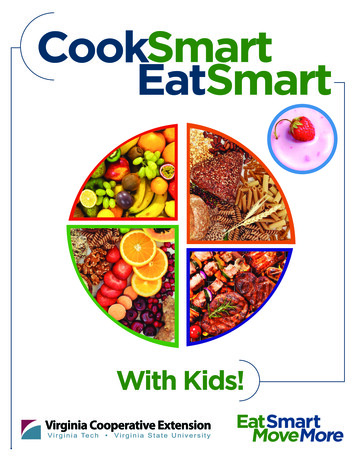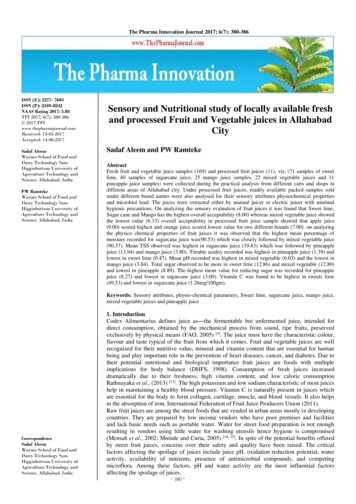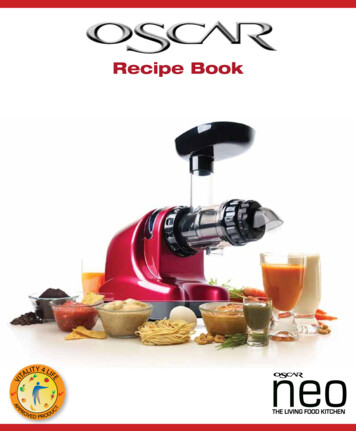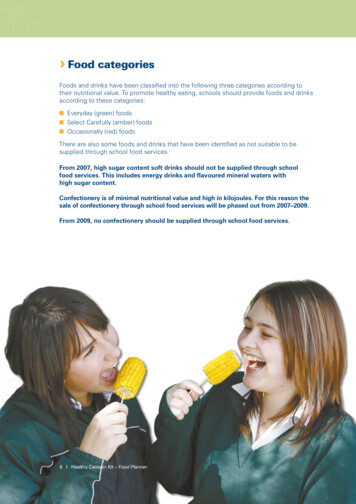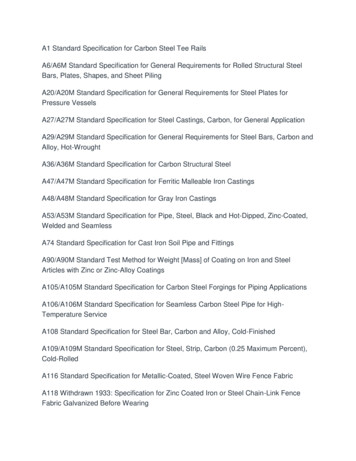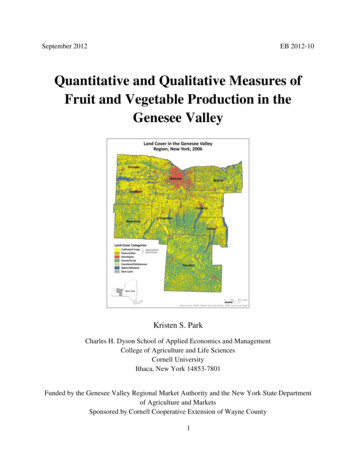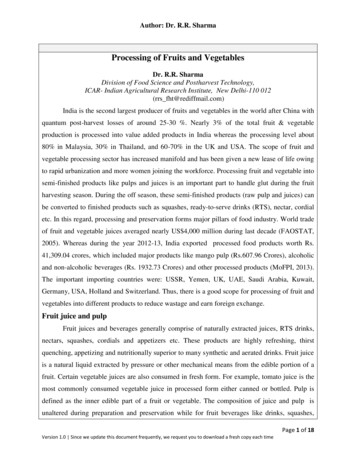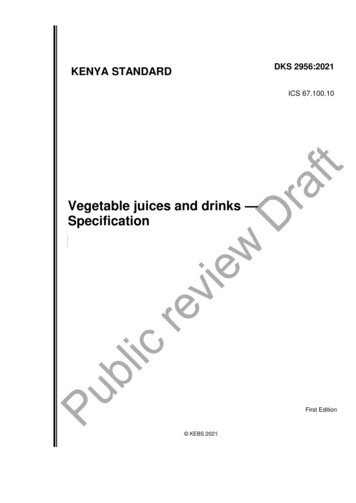
Transcription
DKS 2956:2021KENYA STANDARDICS 67.100.10Vegetable juices and drinks —SpecificationFirst Edition KEBS 2021
DKS 2956: 2021TECHNICAL COMMITTEE REPRESENTATIONThe following organizations were represented on the Technical Committee:Jomo Kenyatta University of Agriculture and Technology — Department of Food Science and TechnologyKevian Kenya Ltd.Government Chemist's DepartmentPremier Foods Ltd.Ministry of Agriculture, Livestock and FisheriesKenya Plant Health Inspectorate ServicesNational Public Health Laboratory servicesNjoro Canning FactoryCoca-Cola East Africa Ltd.Del Monte Kenya Ltd.Kenya Bureau of Standards — SecretariatREVISION OF KENYA STANDARDSIn order to keep abreast of progress in industry, Kenya Standards shall be regularly reviewed. Suggestions forimprovements to published standards, addressed to the Managing Director, Kenya Bureau of Standards, arewelcome. Kenya Bureau of Standards, 2021Copyright. Users are reminded that by virtue of Section 25 of the Copyright Act, Cap. 130 of 2001 of the Laws of Kenya, copyright subsists inall Kenya Standards and except as provided under Section 25 of this Act, no Kenya Standard produced by Kenya Bureau of Standards maybe reproduced, stored in a retrieval system in any form or transmitted by any means without prior permission in writing from the ManagingDirector.ii KEBS 2021 – All rights reserved
KENYA STANDARDDKS 2956: 2021ICS 67.100.10First EditionVegetable Juices and drinks — SpecificationKenya Bureau of Standards, Popo Road, Off Mombasa Road,P.O. Box 54974 - 00200, Nairobi, Kenya 254 020 6948000, 254 722202137, 254 734600471info@kebs.org@KEBS kekenya bureau of standards (kebs) KEBS 2021 – All rights reservediii
DKS 2956: 2021ForewordThis Kenya Standard was prepared by the processed fruits and vegetables Products Technical Committee underthe guidance of the Standards Projects Committee, and it is in accordance with the procedures of the KenyaBureau of StandardsThis Kenya Standard specifies the safety and quality requirements for the Vegetable juices and drinks.In the preparation of this standard the views of all the relevant stakeholders have been taken into considerationDuring the preparation of this standard, reference was also made to the following document:a) CODEX Alimentarius Commission, CODEX STAN 247-2005, General Standard for Fruit Juices and Nectars;b) KS EAS 77; Fruit drinks – Specificationc) KS EAS 948; Fruit Juices and nectarsAcknowledgement is hereby made for the assistance derived from this source.iv KEBS 2021 – All rights reserved
KS 2956:2021Vegetable Juices and drinks — Specification1 ScopeThis Kenya Standard specifies requirements and methods of sampling and test for vegetable juices and drinksintended for direct human consumption or for further processing2 Normative referencesThe following documents are referred to in the text in such a way that some or all of their content constitutesrequirements of this document. For dated references, only the edition cited applies. For undated references, thelatest edition of the referenced document (including any amendments) applies.EAS 38, General standard for labeling of prepackaged foodsEAS 39, Code of practice for hygiene in the food and drink manufacturing industryCodex stan 192, General standard for food additivesEAS 153, Drinking water SpecificationKS EAS 12, Potable water specification that has been quoted in the standard.KS EAS 36, Honey Specifications in the normative referenceEAS 803, Nutrition labelling — RequirementsEAS 804, Claims on food — RequirementsEAS 805, Use of nutrition and health claims — RequirementsISO 874, Fresh fruits and vegetables -- SamplingKS EAS, Code of hygienic practice for dried fruitsCodex Stan 193, General standard for contaminants and toxins in foods ISO 4833 - 2, Methods for themicrobiological examination of foods Part 2: General Guidance for the Enumeration of Micro-Organisms-ColonyCount Technique at 30 CISO 21527-1, Microbiology of food and animal feeding stuffs -- Horizontal method for the enumeration of yeastsand moulds -- Part 1: Colony count technique in products with water activity greater than 0,95 ISO 7251,Microbiology of food and animal feeding stuffs — Horizontal method for the detection and enumeration ofpresumptive Escherichia coli — Most probable number techniqueISO 763, Fruits and vegetable products Determination of ash insoluble in hydrochloric acidISO 2448, Fruit and vegetable products Determination of ethanol contentISO 2172, Fruit juice Determination of solids content Pyknometric methodISO 2173, Fruit and vegetable products Determination of soluble solids Refractometric methodISO 5522, Fruits, vegetables and derived products – Determination of total sulphur dioxide content KEBS 2021 – All rights reserved
ISO 5523, Liquid fruit and vegetable products – Determination of sulphur dioxide content – (Routine method)ISO 6561-1, Fruits, vegetables and derived products — Determination of cadmium content — Part 1: Methodusing graphite furnace atomic absorption spectrometryISO 17240, Fruit and vegetable products — Determination of tin content — Method using flame atomic absorptionspectrometricISO 6633 Fruits, vegetables and derived products -- Determination of lead content -- Flameless atomic absorptionspectrometric methodKS ISO 4833-1, Microbiology of the food chain — Horizontal method for the enumeration of microorganisms —Part 1: Colony count at 30 degrees C by the pour plate techniqueKS ISO 6579-1, Microbiology of the food chain — Horizontal method for the detection, enumeration and serotypingof Salmonella — Part 1: Detection of Salmonella spp3 Terms and definitionsFor the purposes of this document, the following terms and definitions apply.3.1Aseptic packingProduct, which has first been rendered commercially sterile, is packaged, under aseptic conditions, in a sterilecontainer, which is then hermetically sealed3.2AuthenticityMaintenance in the product of the essential physical, chemical, organoleptical and nutritional characteristics ofthe fruit or vegetable from which the product is made3.3BrixSoluble solids content of the juice3.4Commercially sterileProduct has been subjected to a thermal or other physical process, which prevents the survival of viable microorganisms3.5Food grade materialMaterial that will safeguard the hygienic, safety, nutritional, technological, and organoleptic qualities of theproduct.3.6One gas (carbonation) volumeii KEBS 2021 – All rights reserved
Amount of carbon dioxide the water volume absorbs at the standard atmospheric pressure at 15.6 C3.7CarbonationProcess of addition of carbon dioxide to Vegetable juices or drinks to achieve the characteristics of the product atthe specified temperature and pressureProcess of addition of carbon dioxide to fruit drinks The standard is for vegetable juices and drinksRephrase to read: process of addition of carbon dioxide to vegetable juices/ drinks 3.8Preserved by physical meansProduct treated in one of the following ways:a) Canned;b) Subjected to aseptic packing;c) Blanched and frozen;d) Pasteurized and refrigerated; ore) Dehydrated3.9Reconstituted (from concentrate)Product prepared by adding potable water and other permitted ingredients to a concentrated vegetable juice3.10Single vegetable juice/drinkJuice or drink obtained from one kind of vegetableJuice obtained from one kind of vegetable – The scope of the standard covers drinks too. Rephrase to read:Juice or drink obtained from one kind of vegetable4 Description4.1 Product description4.1.1 Vegetable juiceVegetable juice is the unfermented liquid obtained from the edible parts of sound, appropriately mature and freshvegetable or of vegetable maintained in sound condition by suitable means.Replace the words fruit with vegetable4.1.1.1 Juices shall be processed without pips, seeds and peel.4.1.1.2 Some parts or components of pips, seeds and peel, which cannot be removed by Good ManufacturingPractices (GMP), shall be acceptable. KEBS 2021 – All rights reservediii
4.1.1.3 Juice shall be prepared using processes which maintain the essential physical, chemical, organolepticand nutritional characteristics of the juice of the fruit or vegetable from which it is derived.4.1.1.4 Juice may be cloudy or clear and may have restored aromatic substances and volatile flavour components.4.1.1.5 Where juice contains restored aromatic substances and volatile flavour components, these shall beobtained by suitable physical means and shall be recovered from the same kind of fruit or vegetable.NOTE 1 Pulp and cells obtained by suitable physical means, from the same kind of fruit or vegetable, may beadded.NOTE 2 for citrus fruits, pulp or cells are the juice sacs obtained from the endocarp4.1.1.6 Juice shall be obtained as follows:a) Juice directly expressed by mechanical extraction processes; anda) b) Juice from concentrate by the process of reconstituting concentrated Vegetable juice (4.2.2) withpotable water that meets the requirements of EAS 12.4.1.2 Vegetable drink (ready to drink)It is a manufactured beverage intended for direct human consumption which contains vegetable juice, vegetablepulp or other edible parts of the vegetables. It may be made from a single or a mixture of two or morevegetables. It may be sweetened with nutritive or/ and non-nutritive (intense) sweeteners with or without addedcarbon dioxide and other permitted food additives. These beverages may be clear, cloudy, or may containparticulate matter (for example, fruit pieces, crushed pips, seeds and/or peel of the fruit).4.1.3 Vegetable and fruit juice/drink blendLiquid food obtained from either vegetable juice pulp or purées from different kinds of vegetable species,blended with fruit juice or drink4.1.4 Concentrated vegetable juice4.1.4.1 Product that complies with the definition of vegetable juice, except that water has been physically removedin an amount sufficient to increase the Brix level to a value at least 50 % greater than the Brix value forreconstituted juice from the same vegetable.4.1.4.2 In the production of juice that is to be concentrated, suitable processes shall be used and may be combinedwith simultaneous diffusion of the pulp cells or pulp by water, provided that the water extracted soluble solids areadded in-line to the primary juice, before the concentration procedure.4.1.4.3 Juice concentrates may have restored aromatic substances and volatile flavour components.4.1.4.4 Where juice concentrates contain restored aromatic substances and volatile flavour components, theseshall be obtained by suitable physical means and shall be recovered from the same kind of fruit or vegetable.NOTE Pulp and cells obtained from the same kind of fruit or vegetable may be added.4.1.5 Water-extracted vegetable juice4.1.5.1 Water-extracted vegetable juices may be concentrated and reconstituted.iv KEBS 2021 – All rights reserved
4.1.5.2 The solids content of the finished product shall meet the minimum Brix level for reconstituted vegetablejuice specified in the Table 1.4.1.6 Vegetable purée for use in the manufacture of vegetable juices4.1.6.1 Vegetables used in the manufacture of purées shall be sound, appropriately mature, and fresh orpreserved by physical means or by treatments applied in accordance with the applicable provisions of the CODEXAlimentarius Commission.4.1.6.2 Vegetable purée may have restored aromatic substances and volatile flavour components.4.1.6.3 Where vegetable purées contain restored aromatic substances and volatile flavour components, theseshall be obtained by suitable physical means recovered from the same kind of vegetable pulp and cells.4.1.7 Vegetable PulpEdible portions of the vegetable, mashed, or cut into pieces, but not reduced to a puree’4.1.8 Blended or mixed vegetable juice or drinkBlended or mixed vegetable juice and drink is the product obtained by adding water with or without the additionof sugars, syrups and/or honey, and/or sweeteners, obtained from two or more different kinds of fruits. The blendcan be obtained from the following;i.ii.iii.iv.v.vi.vii.4.1.9vegetable juice or drinkVegetable juice or drink fruit blendConcentrated vegetable juiceWater extracted vegetable juice,vegetable puree,Concentrated vegetable puree.Fruit pulpFresh vegetable JuicesFresh vegetable juice is the unfermented but fermentable liquid obtained from the edible part of sound,appropriately mature, ripe and fresh vegetable, freshly squeezed or extracted and packaged as appropriate andwhich;a)b)c)d)e)Contains no additivesHas not been subjected to any preserving process other than chillingClean and free from exogenous foreign matterIs practically free from endogenous foreign matter like seeds and bits of peelIs intended to be sold for consumption within two hours of extraction or six hours with refrigerationNOTE 1 Introduction of aromas and flavours are allowed to restore the level of aromatic substances and volatile flavourcomponents in accordance with good manufacturing practices (GMP).NOTE 2 for citrus fruits, pulp or cells are the juice sacs obtained from the endocarp.4.2 Species descriptionThe species indicated as the botanical name in the Annex A shall be used in the preparation of vegetable juicesand drinks bearing the product name for the applicable vegetable.For Vegetable species not included in the Annex A, the correct botanical or common name shall apply. KEBS 2021 – All rights reservedv
5 Requirements5.1 General5.1.1 Vegetables intended for use or processing of the product shall comply with relevant Kenya standards forfresh vegetables. The vegetable juices and drinks shall have the characteristic colour, aroma and flavour of juicefrom the same kind of vegetable and fruit from which it is made.5.2 Composition and quality5.2.1 Composition5.2.1.1 Basic ingredients5.2.1.1.1 The Brix level of directly expressed vegetable juices shall be the Brix as expressed from the vegetable,and the soluble solids content of the single strength juice shall not be modified, except by blending with the juiceof the same kind of vegetable.5.2.1.1.2 Reconstitution of concentrated vegetable juice shall be in accordance with the minimum Brix level intable 1, excluding the solids of any added optional ingredients and additives.5.2.1.1.3 Where no Brix level is specified in table 1, or in the case of vegetables, minimum Brix shall be calculatedon the basis of the soluble solids content of the single strength juice.5.2.1.1.4 Potable water shall be used in the reconstitution of vegetables juices and drinks5.2.1.2 Other permitted ingredients5.2.1.2.1 Sugars (Sucrose, glucose (dextrose anhydrous) or fructose) and / or non – nutritive sweeteners withless than 2% moisture may be added only to products intended for sale to the consumer or for catering purposes.Honey may also be added.The quality of honey used shall comply with KS EAS 36.Both sugars and acidifying agents shall not be added to the same vegetable juice or drink5.2.1.2.2 Syrups, liquid sucrose, invert sugar solution, invert sugar syrup, fructose syrup, liquid cane sugar,isoglucose and high fructose syrup are allowed only in vegetable juice from concentrate, concentrated vegetablejuices and concentrated vegetable puréeNOTE 1 5.2.1.2.1 and 5.2.1.2.2 are applicable only to products intended for sale to the consumer or for cateringpurposes.NOTE 2 the addition of both sugars defined in 5.2.1.2.1 and 5.2.1.2.2 and acidifying agents as listed in theGeneral Standard for Food Additives (GSFA) to the same vegetable juice is prohibited.5.2.1.2.6 Salt, spices and aromatic herbs and their natural extracts may be added to tomato and vegetable juices.5.2.1.2.7 For the purposes of product fortification, when permitted by national legislation, essential nutrients suchas vitamins and minerals may be added to products described in 4.1. Such additions shall comply with the mostrecent versions of relevant CODEX Alimentarius Commission standards.NOTEAny optional ingredients added are subject to ingredient labelling requirements (see Clause 12).5.2.1.2.8 Non-nutritive sweeteners approved for use in the most recent version of the CODEX General Standardfor Food Additives (GSFA) may be used in vegetable drinks, as specified in the GSFA.5.2.2 Quality criteriavi KEBS 2021 – All rights reserved
5.2.2.1 Vegetable juices and drinks shall have the characteristic colour, aroma and flavour of juice from the samekind of vegetable from which it is made.5.2.2.2 The vegetable shall retain no more water from washing, steaming or other preparatory operations thantechnologically unavoidable.5.3 Verification of composition, quality and authenticityVegetable juices and drinks shall be subject to testing for authenticity, composition, and quality where applicableand where required. The analytical methods used should be as specified in table 1.5.2Specific requirementThe vegetable juices and drinks shall conform to the requirements in Table 1.Table 1 — Requirements for Vegetable juices and drinksCharacteristicRequirementMethod of testEthanol content, %, max.0.3ISO 2448Acid insoluble ash, %, max.0.02ISO 763Min (%) of fruit juice/fruit puree inthe final product;vegetable juice drink(RTD)GMP10Vegetable JuiceNot less than 25pH:Vegetable drink (Min)Vegetable Juice (Max)2.54.5Total soluble solids (0Brix), min (%)10ISO 2173Not less than one gasvolumeAnnex BCO2 content (if added)PH MeterNote 1; those vegetable juices with less than 10 % brix , shall be characteristic of thenatural vegetable brix6Food additives6.1 Food additives listed in the CXS 192; General Standard for Food Additives (GSFA) in Vegetable juices maybe used in foods subject to this Standard. GSFA approved food additives may be used in related products notlisted above.7Processing aids7.1 Processing aids listed in Table 2 may be used in the production of foods subject to this standard.7.2 Processing aids shall be used as specified in Table 2 and or as limited by GMPTable 2Table 2 Maximum level of use of approved food processing aids in line with good manufacturingpracticesFunctionAntifoaming Agent KEBS 2021 – All rights reservedSubstancea)Polydimethylsiloxanevii
Adsorbent clays (bleaching, natural or activated earths)Adsorbent resinsActivated carbon (only from plants)BentoniteCalcium hydroxideb)CelluloseClarifying AgentsChitosanColloidal silicaDiatomaceous earthGelatin (from skin collagen)Ion exchange resins (cation and anion)Isinglassc)Filtration um casseinateb)Potassium tartrateb)Flocculating AgentsPrecipitated calcium carbonateRice hullsSilicasolc)Sodium caseinateb), d)Sulphur dioxideTanninPectinases (for breakdown of pectin),Proteinases (for breakdown of proteins),Enzyme preparationseAmylases (for breakdown of starch) andCellulases (limited use to facilitate disruption of cell walls).NitrogenPacking gasfa)Carbon dioxide10 mg/L is the maximum residue limit of the compound allowed in the final product.b)Only in grape juicec)Use of these processing aids should take into account their allergenic potential. If there is any carryover of these processingaids into finished product, they are subject to ingredient declaration in accordance with KS EAS 38.d)10 mg/L maximum limit (as residual SO ) when determined in accordance with ISO 5522 and ISO 55232e)Enzyme preparations may be used as processing aids provided these preparations do not result in a total liquefaction and donot substantially affect the cellulose content of the processed vegetable.f)May also be used for example, for preservation8Contaminants8.1 Pesticide residuesviii KEBS 2021 – All rights reserved
The products covered by the provisions of this Standard shall comply with maximum residue limits (MRLs) forpesticides as established by the CODEX Alimentarius Commission for these products, where no NationalRegulation exists.8.2 Heavy metal contaminantsThe products covered by the provisions of this standard shall conform to those maximum limits for Heavy metalscontaminants established by the Codex Alimentarius Commission for these products in Table 5.Table 5 — Maximum limits for heavy metal contaminants for vegetable juices and drinksS/Nii)Lead (Pb)Maximum level(mg/kg)0.3 mg/kgvi)Tin (Sn)150 mg/kgKS ISO 2447viii)Cadmium (cd)0.2 mg/kgKS ISO 6561-1ContaminantTest methodKS ISO 95268.3 Other contaminantsThe products covered by the provisions of this Standard shall comply with the maximum residue limits (MRLs) forcontaminants as established by the CODEX Alimentarius Commission for these products, where no nationalregulations exist.9Hygiene9.1 The products covered by the provisions of this Standard shall be prepared and handled in accordance withKS EAS 39 and other relevant Codes of Hygienic Practice and Codes of Practice.9.2The products shall conform to microbiological criteria in Table 6 and those provided in KS 2455.Table 6 — Microbiological limits for vegetable juices and drinksS/Ni)iii)iii)iv)v)vi)MicroorganismTotal plate count (cfu/g), max.Escherichia coli, per 25 g,(cfu/g), max.Yeasts and moulds (cfu/g), max.Listeria spp., per 25 gL.monocytogenesSalmonella, per 25 gEnterobacteriaceae, per gLimit (CFU/G)Test method1000AbsentISO 4833KS ISO 725130AbsentAbsentAbsent10KS ISO 6888-1ISO 4833-1KS ISO 11290-1 &2KS ISO 6579-110 PackagingThe products shall be packaged in food grade containers11 Weights and measuresThe products shall be packaged in accordance with the Weights and Measures regulations KEBS 2021 – All rights reservedix
12 Labelling12.1 General labeling requirementsIn addition to the requirements of EAS 38, 803,804 and 805 the following specific labelling requirements shallapply and shall be legibly and indelibly marked on the container;12.2Name of the productThe name of the product shall bear the name of the vegetable used as defined in 4.1.The vegetable name shall be filled in the blank of the product name mentioned under this clause. These namesmay only be used if the product conforms to the definition in 4.1 or which otherwise conform to this standard.Vegetable drink (ready to drink)Vegetable and fruit juice/drink blendConcentrated vegetable juiceWater-extracted vegetable juiceVegetable puréeVegetable PulpBlended or mixed vegetable juice and drink11.1.2Vegetable JuiceThe name of the product shall be “ juice” or “juice of ”.11.1.3Concentrated Vegetable juiceThe name of the product shall be “concentrated juice” or “ juice concentrate”.11.1.4Water extracted vegetable juiceThe name of the product shall be “water extracted juice” or “water extracted juice of ”.11.1.5Vegetable PuréeThe name of the product shall be “ purée” or “Purée of ”.11.1.6Vegetable PulpThe name of the product shall be “ pulp” or “Pulp of ”.11.1.7Vegetable and fruit juice/drink blendIn the case of vegetable juice products (4.1) manufactured from two or more vegetables, and blended with fruitjuice or drink, the product name shall include the names of the Vegetable juices comprising the mixture indescending order of proportion by weight (m/m) or the words "Vegetable and fruit juice/drink blend", " a vegetableand fruit juice/drink mixture", "mixed vegetable and fruit juice/drink" or other similar wording.11.1.8Products from concentrateFor vegetable juice, if the product contains or is prepared from concentrated juice and water or the product isprepared from juice from concentrate and directly expressed juice, the words “from concentrate” or “reconstituted”x KEBS 2021 – All rights reserved
shall be entered in conjunction with or close to the product name, standing out well from any background, in clearlyvisible characters, not less than half the height of the letters in the name of the juice.11.1.9 Date of manufacture11.1.10 Expiry date.11.1.11 Brand /trade name.11.1.12 List of ingredients.11.1.13 Net contents.11.1.14 Instructions for use.11.1.15 Storage conditions.11.1.16 Name and address of the manufacturer.11.1.17 Country of origin.11.2.2 Additional requirements11.2.2.1Products prepared by physically removing water from the vegetable juiceFor vegetable juices or mixed vegetable juices/drinks/purées, if the product is prepared by physically removingwater from the vegetable juice in an amount sufficient to increase the Brix level to a value at least 50% greaterthan the Brix value established for reconstituted juice from the same vegetable, as indicated in Table 1, it shall belabelled “concentrated”.11.2.2.2Products one or more of the optional sugar or syrup ingredients are addedFor products defined in 4.1.1 to 4.1.5, where one or more of the optional sugar or syrup ingredients as are added,the product name shall include the statement called “sugar(s) added” after the vegetable juice or mixed vegetablejuice’s name.11.2.2.3Products to be reconstituted before consumptionWhere concentrated vegetable juice, concentrated vegetable purée, or mixed concentrated fruit juice/ purée is tobe reconstituted before consumption as vegetable juice, vegetable purée, or mixed vegetablejuices/purées/drinks, the label shall bear appropriate directions for reconstitution on a volume/volume basis withwater to the applicable Brix value in the Table 1 for reconstituted juice.11.2.2.4Varietal denominationsDistinct varietal denominations may be used in conjunction with the common fruit names on the label where suchuse is not misleading.11.2.2.5Juice content declarationVegetable juices and drinks shall be conspicuously labelled with a declaration of “juice content %” with theblank being filled with the percentage of purée and/or vegetable juice computed on a volume/volume basis.The words “juice content %” shall appear in close proximity to the name of the product in clearly visiblecharacters, not less than half the height of the letters in the name of the juice. KEBS 2021 – All rights reservedxi
11.2.2.6Nutrition declarationAny added essential nutrients declaration shall be labelled in accordance with US EAS 803, US EAS 804, USEAS 805.An ingredient declaration of “ascorbic acid” when used as an antioxidant does not, by itself, constitute a “VitaminC” claim.For fruit nectars in which a food additive sweetener has been added in order to replace wholly or in part the addedsugars or other sugars or syrups, including honey and/or sugars derived from vegetables any nutrient contentclaims related to the reduction in sugars shall conform to US EAS 803, US EAS 804 and US EAS 805,.11.2.2.7 Pictorial representationsA pictorial representation of vegetable(s) on the label shall not mislead the consumer with respect to the fruit soillustrated.11.2.2.9Products containing added carbon dioxideWhere the product contains added carbon dioxide minimum of one gas volume the term “carbonated” or“sparkling” shall appear on the label near the name of the product.11.2.2.10 Vegetable juice containing spices and/or aromatic herbsWhere vegetable juice contains spices and/or aromatic herbs in accordance with Section 5.1.2.6 the term “spiced”and/or the common name of the aromatic herb shall appear on the label near the name of the juice.11.2.2.11 Juice containing added pulp, cells, aromatic substances or volatile flavour componentsPulp and cells added to juice over that normally contained in the juice shall be declared in the list of ingredients.Aromatic substances, volatile flavour components, pulp and cells added to nectar over that normally contained inthe juice shall be declared in the list of ingredients.12 Methods of samplingThe fruit nectar and concentrate shall be sampled in accordance to ISO. 874xii KEBS 2021 – All rights reserved
ANNEX A: LIST OF VEGETABLES COMMON NAME AND THEIR BOTANICAL NAMESARTICHOKES Cynara scolymusASPARAGUS Asparagus officinalisBroccoli Brassica oleracea var. botrytisBrussels sprouts Brassica oleracea var. gemmiferaCabbage (red, white, Savoy) Brassica oleracea var. capitataCabbage, Chinese Brassica chinensisCabbage, for fodder Brassica spp.Carrot, Daucus carota ssp. sativaCauliflower Brassica oleracea var. botrytisCelery Apium graveolensCucumber Cucumis sativusEggplant Solanum melongenaEndive Cichorium endiviaFenugreek Trigonella foenum-graecumFig Ficus caricaKale Brassica oleracea var. acephalaLeeks other alliaceous vegetable leeks Allium porrumLettuce Lactuca sativa;Mustard Brassica nigra; Sinapis albaOkra Abelmoschus esculentusPumpkin, edible Cucurbita spp.Radish Raphanus sativus (inc. Cochlearia armoraciaRed beet Beta vulgarisRutabaga (swede) Brassica napus var. napobrassicaSpinach Spinacia oleraceaPumkins, Squash, Gourds Cucurbita spp.Tomato Lycopersicon esculentumTurnip, edible Brassica rapa KEBS 2021 – All rights reservedxiii
Note 1: If a juice is manufactured from a fruit not mentioned in the above list, it shall, nevertheless, comply with all the provisions of thestandard, except that the minimum Brix level of the reconstituted juice shall be the Brix level as expressed from the vegetable used to makethe concentrate.Note 2: For mixed and blended vegetables juices and drinks the brix of the product shall be declared in the labelANNEX B: Method of measuring gas volumePrincipleThe method involves snifting of the top gas. The pressure reading should drop to 2 psi, to remove the air beforetesting for carbon dioxide volume. In so doing correction of altitude as per table should be considered as pressureis affected by altitude.The apparatus consists of pressure gauge having a hollow spike with holes in its side. The bottle is inserted fromthe side into the slot provided in the neck of the carbon dioxide tester and is secured in place by tightening with athreaded system. The pressure gauge is inserted until the needle point touches the crown cork. There is a sniftvalve on the gauge stem which is kept closed until the needle point of the pressure gauge is forced through thecrown cork. The reading is noted on the gauge.ProcedureClamp the bottle in the frame of the gas volume tester. Pierce the crown cork b
Vegetable juice is the unfermented liquid obtained from the edible parts of sound, appropriately mature and fresh vegetable or of vegetable maintained in sound condition by suitable means. Replace the words fruit with v
